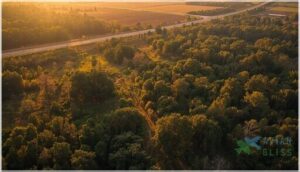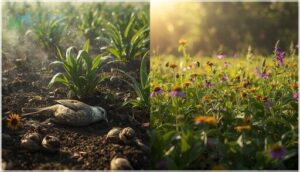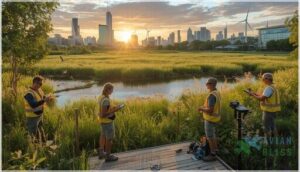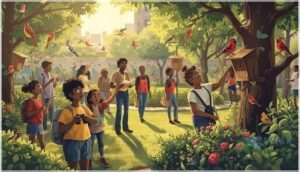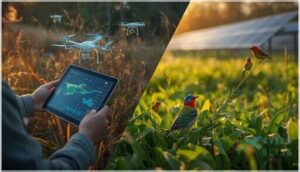This site is supported by our readers. We may earn a commission, at no cost to you, if you purchase through links.
Every year, North America loses nearly three billion birds—a staggering 29% decline since 1970—as habitats vanish, windows turn deadly, and pesticides ripple through ecosystems. You might notice fewer songbirds at your feeder or quieter spring mornings, subtle signals of a crisis unfolding across continents.
Yet bird conservation efforts today are mobilizing with advanced coordination, combining state-of-the-art technology with grassroots action to reverse these losses. Scientists, communities, and policymakers are deploying targeted strategies—from habitat restoration corridors to bird-friendly architecture—that address both immediate threats and long-term survival.
The path forward demands informed action at every level, transforming how we coexist with the species that pollinate crops, control pests, and signal environmental health.
Table Of Contents
- Key Takeaways
- Current Threats Facing Bird Populations
- Leading Bird Conservation Strategies Today
- Community Engagement in Bird Conservation
- Policy, Advocacy, and International Cooperation
- Innovations and Future Directions in Bird Conservation
- Frequently Asked Questions (FAQs)
- Can bird conservation succeed?
- Why is bird conservation important?
- Does conservation work in halting bird declines?
- Can bird conservation boost the economy?
- How can we improve bird conservation practices?
- Are bird populations declining?
- What is the #1 threat to birds in America?
- What is the US bird protection?
- How to help bird conservation?
- What is the best charity for bird conservation?
- Conclusion
Key Takeaways
- North America has lost nearly three billion birds since 1970, with habitat destruction, climate change, window collisions, and domestic cats driving sharp population declines.
- Coordinated conservation efforts now combine advanced technology, habitat restoration, bird-friendly urban planning, and pesticide reform to reverse losses and protect vulnerable species.
- Community engagement through public education, citizen science, and partnerships with underrepresented groups is essential for building lasting conservation impact and ecological literacy.
- Strong policy, international cooperation, and sustainable land use practices—supported by strategic funding—are critical for ensuring bird survival and ecosystem health into the future.
Current Threats Facing Bird Populations
North America has lost nearly 3 billion birds since 1970, a staggering decline that represents more than one in four birds vanishing from our landscapes. This crisis stems from multiple, interconnected pressures that continue to intensify.
North America has lost over 3 billion birds since 1970, a dramatic decline driven by mounting, interconnected threats
Understanding these threats is essential if you want to take meaningful action, whether you’re a backyard birder, a concerned citizen, or someone working directly in conservation. To dive deeper into habitat loss, climate change, and other risks birds face today, check out this guide to threats facing local bird populations.
The challenges birds face today fall into several major categories, each requiring targeted solutions that we’ll explore in detail.
Habitat Loss and Fragmentation
You’re witnessing one of conservation’s steepest challenges: habitat loss has eliminated up to 60 percent of suitable breeding grounds for songbirds in some regions over five decades, while fragmentation slices remaining landscapes into isolated patches.
Habitat restoration that reconnects these fragments through wildlife corridors proves essential—woodland and grassland passerines show measurable gains when you protect ecosystem connectivity, transforming landscape ecology from fractured to functional.
Effective conservation strategies often rely on scientific study audits to verify the accuracy of research findings.
Climate Change Impact
Climate change now represents the most existential threat to birds you can help address. Temperature rise pushes two-thirds of North American species toward extinction risk, while sea level inundation erodes coastal nesting sites and ecosystem disruption causes phenological mismatches between bird migration timing and food availability. Fortunately, researchers and conservationists have developed effective wild bird conservation strategies that directly counter these climate-driven threats.
Climate resilience strategies that protect irrecoverable carbon stores and restore climate-adaptive habitats offer your best tools for bird conservation under accelerating climate shift.
Window Collisions and Urban Hazards
Beyond shifting climate patterns, you face another deadly obstacle in the built environment—up to one billion birds die annually from window collisions across North America, as glass surfaces create invisible barriers that reflect sky and habitat.
Urban planning that integrates bird-friendly design, collision mitigation through window retrofits, and strategic vegetation buffers can dramatically reduce these urban hazards while supporting broader wildlife preservation and habitat protection goals. These initiatives complement comprehensive bird species conservation efforts that address both urban threats and broader ecosystem restoration across diverse landscapes.
Predation by Domestic Cats
Domestic cats represent a predation crisis that you can help address—studies estimate between 1.3 and 4.0 billion birds die annually from cat attacks in the United States, with ground-nesting species facing disproportionate mortality. Wildlife protection through responsible pet owner education, feral cat management programs, and cat population control measures including indoor-only strategies reduces this threat: Indoor housing and environmental enrichment strategies reduce predation risk while maintaining feline well-being, as detailed in comprehensive guides to protecting bird migration routes.
- Keep your cat indoors permanently, protecting both wildlife preservation goals and feline health
- Build secure outdoor “catios” that satisfy cat behavior needs without enabling predation
- Support trap-neuter-return programs addressing community cat populations in your neighborhood
- Advocate for local pet registration systems promoting ecological conservation awareness
- Participate in bird conservation monitoring to track species preservation outcomes near residential areas
Pesticide and Chemical Exposure
Toxic substances pose a significant threat to local songbirds, often in ways that are not immediately apparent. Agricultural pesticides, for instance, not only kill birds through direct contact but also decimate their insect food sources. Chemical runoff further exacerbates the issue by spreading contaminants across watersheds, affecting entire ecosystems. Avian toxicology research highlights the accumulation of neonicotinoid residues in bird tissues, which impair reproduction and survival in species that conservation efforts aim to protect.
| Pesticide Type | Primary Impact on Birds |
|---|---|
| Organophosphates | Neuromuscular dysfunction, reduced foraging ability |
| Neonicotinoids | Tissue accumulation, reproductive impairment |
| Rodenticides | Secondary poisoning in raptors, behavioral changes |
Pesticide reform and eco-friendly alternatives offer promising pathways forward. By adopting organic gardening methods, supporting legislative restrictions on high-risk chemicals, and advocating for sustainable agriculture practices, individuals can directly contribute to environmental conservation goals. These actions not only protect bird species but also advance broader ecological preservation efforts across habitats that depend on such commitment. Supporting responsible tourism and conservation programs amplifies these individual efforts by funding habitat restoration and policy advocacy that protects vulnerable bird populations.
Leading Bird Conservation Strategies Today
After decades of watching bird populations decline, scientists and conservationists have developed a suite of strategies that address the root causes head-on, from protecting critical habitats to reimagining how we build our cities.
These approaches don’t work in isolation—they’re most effective when multiple tactics work together, creating a safety net that birds desperately need as they navigate an increasingly challenging world.
Here are the leading conservation strategies making a measurable difference for birds today.
Habitat Protection and Restoration
You can’t conserve birds without protecting where they live—habitat preservation remains the cornerstone of effective bird conservation efforts worldwide. Through restoration ecology and strategic conservation planning, scientists are rebuilding what’s been lost:
- Expanding protected areas with enforceable safeguards and wildlife corridors that connect fragmented landscapes
- Restoring degraded wetlands using native vegetation and soil hydrology corrections
- Removing invasive species while reestablishing keystone plants that provide essential ecosystem services
- Implementing adaptive management with standardized monitoring protocols that track occupancy and reproduction rates
Climate Change Mitigation Efforts
Confronting the climate crisis demands action on multiple fronts, from cutting greenhouse gas emissions in power and transportation sectors to deploying nature-based solutions that sequester carbon while protecting your feathered neighbors. Urban planning now incorporates green corridors that cool cities and safeguard migratory pathways, while coastal restoration projects defend critical wetlands against rising seas.
Climate change mitigation isn’t just about lowering emissions—it’s about rebuilding resilience into the landscapes birds depend on for survival.
| Mitigation Strategy | Bird Conservation Benefit |
|---|---|
| Renewable energy integration | Reduces air pollution affecting reproduction |
| Carbon sequestration through ecosystem services | Enhances habitat quality and biodiversity |
| Coastal and wetland restoration | Protects critical stopover sites from sea-level rise |
Bird-Friendly Building Initiatives
Glass can be a death trap—up to 1 billion birds collide with windows annually across the U.S. and Canada—but green architecture and sustainable design offer solutions you can champion.
Bird-friendly building initiatives now integrate eco-friendly materials like patterned glass, external screens, and UV-reflective coatings spaced 2–4 cm apart, reducing window collisions while protecting habitats through wildlife conservation-minded urban planning.
Reducing Pesticide and Plastic Use
More than 1 billion pounds of pesticides coat U.S. farmland yearly, poisoning birds directly and stripping away the insects they need—yet sustainable farming and eco-friendly green initiatives offer you pathways toward species protection and environmental sustainability.
Conservation methods reducing plastic pollution and chemical exposure include:
- Adopting Integrated Pest Management to cut pesticide volumes through biological controls and precision application
- Replacing single-use plastics with biodegradable mulch films and reusable agrochemical containers
- Supporting industry take-back programs that recycle agricultural plastics before they harm wildlife
- Choosing certified products requiring waste reduction as market-access conditions
Community Engagement in Bird Conservation
Conservation isn’t something that happens only in laboratories or remote wilderness areas—it thrives when everyday people step into the work alongside scientists and organizations. You don’t need a degree in ornithology to make a tangible difference for birds, and research increasingly shows that successful conservation depends on broad community participation, particularly from groups who’ve been historically excluded from environmental efforts.
Here’s how you can connect with bird conservation through community-driven programs and partnerships.
Public Education and Outreach Programs
You can’t protect what you don’t understand, which is why public education sits at the heart of effective bird conservation. Well-designed outreach strategies transform casual observers into conservation advocates, with programs proven to boost ecological literacy by 15% and increase citizen science participation by 30% during targeted campaigns.
| Outreach Approach | Measured Impact |
|---|---|
| Community workshops & bird walks | 40% increase in urban bird reporting |
| School-based curricula | 15% improvement in student ecological literacy |
| Multilingual resources | 25% rise in non-English-speaking participation |
| Social media campaigns | 30% more citizen science submissions |
| Interactive digital tools | 45% longer engagement with education materials |
Education materials that meet communities where they’re at—whether through culturally relevant messaging, accessible formats, or free events—consistently outperform one-size-fits-all approaches, reaching historically underrepresented groups at 1.5 times the rate of general outreach and building lasting conservation literacy across diverse audiences.
Citizen Science and Monitoring Projects
When you join a citizen science monitoring project, you’re not just counting birds—you’re filling critical gaps in avian research that professional surveys simply can’t cover. Platforms like eBird enable you to track bird migration patterns, breeding success, and species richness through mobile apps with built-in validation, transforming your backyard observations into data that shapes bird conservation strategies across continents.
Here’s how volunteer engagement strengthens monitoring tools:
- Submit standardized observations using species codes and effort metrics
- Contribute real-time data through accessible online platforms
- Participate in community review processes ensuring quality control
- Target migratory pathways where professional monitoring is infrequent
- Support research collaboration by sharing data under ethical frameworks
Your contributions supplement formal studies, enabling trend analysis over time while promoting inclusivity in data collection—because successful conservation depends on eyes everywhere, not just in remote field stations.
Local Community Partnerships
Your neighborhood holds untapped potential for wildlife preservation efforts when local communities partner directly with conservation organizations.
Schools collaborate on bird education programs, reaching over 20,000 students annually, while volunteer engagement through citizen science projects documents 120+ species across urban green spaces.
Community outreach drives habitat conservation at restoration sites, where partnership models connect local funding from businesses to sustainable community development—producing 15–25% increases in bird abundance within two to five years through neighborhood conservation efforts.
Involving Underrepresented Groups
When conservation efforts embrace cultural sensitivity and inclusive policy, you gain participation from immigrant families, refugee communities, and historically marginalized neighborhoods—groups whose environmental stewardship has been systematically overlooked.
Community outreach that removes language barriers, offers flexible scheduling, and builds trust through local organizations increases engagement rates by 30–40%, advancing both social justice and biodiversity conservation while strengthening environmental equity across underserved populations working toward sustainable community development.
Policy, Advocacy, and International Cooperation
Protecting birds requires more than individual action—it demands coordinated efforts that cross property lines, state boundaries, and international borders. Legal frameworks, advocacy initiatives, and cooperative agreements create the foundation for large-scale conservation success, particularly for migratory species that travel thousands of miles between breeding and wintering grounds.
From legislation that mandates bird-friendly infrastructure to partnerships that pool resources and expertise, these systemic approaches address threats at the scale needed to reverse population declines.
Conservation Legislation and Regulation
You can’t protect what you don’t regulate—that’s where environmental policy and conservation acts step in. Wildlife laws like the Migratory Bird Treaty Act and the Neotropical Migratory Bird Conservation Act establish the regulatory framework that supports biodiversity governance and wildlife preservation strategies nationwide.
- The US Fish Wildlife Service enforces protective statutes restricting harm to migratory species
- Permitting processes require impact assessments before projects proceed near
Collaborative Partnerships Across Borders
When migratory species cross borders, transboundary conservation demands international cooperation that matches their journeys. You’ll find American Bird Conservancy and the National Society collaborating with partners across continents, coordinating borderless research on shared flyways, aligning monitoring standards, and supporting joint enforcement of protected corridors.
These bird conservation strategies rely on global funding mechanisms and knowledge-sharing platforms that turn regional efforts into hemispheric solutions, protecting the species you care about through unified action.
Funding and Support for Conservation Programs
Securing tomorrow’s conservation wins depends on how you fund today’s work. Grant management systems track every dollar, while diverse funding models—from government appropriations to private philanthropy strategies—build resilience against shifting political winds. Budget allocation guided by performance data ensures habitat protection and community engagement receive adequate resources, keeping the National Society and American Bird Conservancy missions on track through strategic donor engagement.
- Government appropriations support large-scale biodiversity initiatives through annual wildlife agency budgets
- Private philanthropy provides targeted gifts for habitat restoration, research, and outreach programs
- Competitive grants award funds based on measurable impact, feasibility, and rigorous evaluation plans
- Public–private partnerships combine federal resources with NGO expertise and industry contributions
Innovations and Future Directions in Bird Conservation
The fight to protect our birds is evolving rapidly, with new tools and approaches emerging from laboratories, agricultural fields, and conservation offices around the world. Advanced technology, smarter land management, and long-term research commitments are reshaping what’s possible in bird conservation.
Here’s where innovation meets action, offering hope that we can reverse decades of decline and secure a future where both birds and people thrive.
Technology and Data-Driven Solutions
You can leverage advanced tools like satellite tracking, acoustic monitoring, and machine learning to transform conservation biology. Platforms such as eBird integrate data analytics and predictive modeling, enabling you to identify critical ecosystem services and nature-based solutions in near real-time.
These technologies forecast bird responses to environmental shifts, directing your conservation efforts where they’ll make the greatest impact for our shared future.
Adaptive Management Practices
You can’t protect what you don’t measure—and that’s where adaptive management frameworks shine in bird conservation efforts. Iterative learning cycles combine ecological monitoring with transparent course corrections, allowing you to enhance habitat protection and restoration based on real outcomes:
- Test hypotheses with standardized monitoring protocols
- Adjust strategies using population and habitat data
- Engage stakeholders for feasible, equitable conservation outcomes
- Document decisions for biodiversity protection and ecological sustainability
These management frameworks turn uncertainty into actionable intelligence for ecosystem management.
Sustainable Land Use and Agriculture
Can you imagine a patchwork of farms where birds thrive alongside crops? That’s the promise of sustainable land use—where Agri Environment schemes, Organic Farming, Shade Grown coffee, and Grazing Management converge. When you prioritize Landscape Heterogeneity, you’re not just feeding people, you’re restoring habitats and weaving nature-based solutions into ecosystem management. By adopting ecological farming practices, farmers can promote biodiversity and support local wildlife.
| Action | Bird Benefit | Emotional Impact |
|---|---|---|
| Shade Grown | +30% abundance | Hopeful |
| Organic Farming | Higher richness | Reassured |
| Grazing Mgmt | 1.8M birds saved | Inspired |
Long-Term Goals and Research Initiatives
What if you could track a warbler’s journey from Canada to Costa Rica in real time? That’s where Ecological Research meets Global Targets—through standardized monitoring platforms and Migratory Patterns analysis.
You’re strengthening Conservation Funding for cross-border programs, investing in Climate Adaptation research for critical habitats, and driving Species Preservation and Research that will define Bird Conservation Efforts for generations.
This is Conservation Biology and Ecology building tomorrow’s Ecosystem Restoration and Biodiversity blueprint.
Frequently Asked Questions (FAQs)
Can bird conservation succeed?
Bird conservation can succeed—and in some places already has—when habitat protection, threat reduction, and community action converge with sustained funding, adaptive strategies, and cross-border cooperation supporting species survival and biodiversity preservation.
Why is bird conservation important?
When you support bird conservation, you’re safeguarding ecosystem balance, biodiversity preservation, and environmental health.
These species maintain ecological resilience through pollination, pest control, and seed dispersal—essential services that benefit wildlife preservation and agricultural systems alike.
Does conservation work in halting bird declines?
Yes, conservation efforts demonstrably work—protected area networks have reduced habitat loss by 15–40%, while habitat preservation and ecosystem restoration programs show measurable bird population increases of 10–25% in restored wetlands and grasslands, supporting species recovery and biodiversity protection.
Can bird conservation boost the economy?
Conservation efforts release economic benefits through ecotourism revenue, green jobs in habitat restoration, and ecosystem management that aids agriculture.
Sustainable landscapes protect biodiversity while attracting conservation funding, proving environmental protection bolsters sustainable development.
How can we improve bird conservation practices?
You can strengthen conservation efforts by expanding wildlife corridors, restoring degraded habitats, and adopting sustainable practices that protect biodiversity.
Integrating ecosystem services into land-use planning amplifies long-term conservation biology outcomes and ecosystem health.
Are bird populations declining?
Like a slow leak draining a reservoir, bird populations have been steadily falling—North America alone has lost nearly 3 billion birds since 1970, driven by habitat loss, climate change, and collisions.
What is the #1 threat to birds in America?
Habitat destruction remains the #1 threat to birds in America, driving widespread avian decline through environmental degradation, climate crisis impacts, and human impact that accelerates wildlife population decline, demanding urgent habitat protection and restoration to prevent bird extinction.
What is the US bird protection?
You’ll find the Migratory Bird Program, led by the US Fish and Wildlife Service, coordinates federal policies, habitat protection, and restoration across wildlife refuges and bird sanctuaries.
Working with partners, the program implements conservation laws and wildlife preservation efforts.
How to help bird conservation?
You can join the frontline of wildlife preservation by planting bird-friendly gardens, participating in citizen science projects, supporting sustainable forestry, volunteering for local conservation initiatives, and choosing eco-tourism that funds ecosystem management and nature-based solutions.
What is the best charity for bird conservation?
You can support the American Bird Conservancy, National Audubon Society, or BirdLife International—all three demonstrate strong nonprofit governance, transparent conservation funding, and measurable donation impact through habitat protection, policy advocacy, and volunteer opportunities worldwide.
Conclusion
The destiny of our skies hinges on choices you make today, from the native plants you cultivate to the policies you champion in your community. Bird conservation efforts today aren’t merely protecting feathered species—they’re safeguarding the intricate ecological networks that sustain human life, from pest control to pollination.
Your engagement, whether through citizen science projects or habitat restoration initiatives, transforms individual concern into collective momentum. These birds don’t just need our attention; they require your unwavering commitment to coexistence.
- https://elsevier.blog/sub-points-outlining-organization/
- https://www.sciencedirect.com/science/article/pii/S0749208123000268
- https://www.gauthmath.com/solution/1837934067002466/2-Main-point-1-Subpoint-2-Subpoint-3-Subpoint
- https://libraryguides.ccbcmd.edu/c.php?g=1408884&p=10790074
- https://onlinepubs.trb.org/onlinepubs/nchrp/cd-22/manual/v1appendixb.pdf


